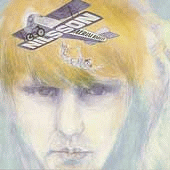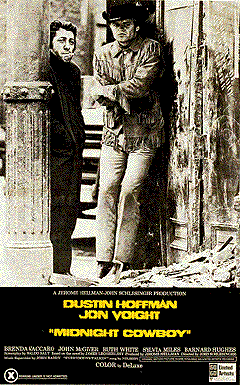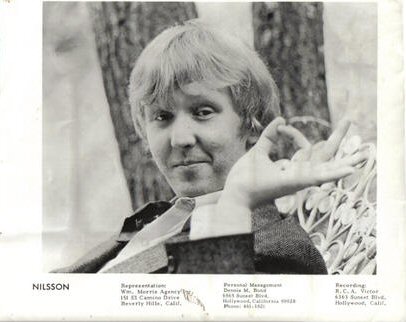![]()
 Aerial Ballet
Aerial Ballet
![]()
With 'Pandemonium Shadow Show' having gained great critical acclaim (if not earth-shattering profits - in fact no profit at all for several years!) he obviously made a decision to make this, his second RCA album, far less showy and out-going and to concentrate more on the human condition, emotions and relationships. The cover versions, with one notable exception, of course, are gone, the rest of the songs 100% 'Harry'.
Many of the same musicians reassembled to make 'Aerial
Ballet' who had played on 'PSS'. The same producer Rick Jarrard and
arranger George Tipton were at the helm and there was still a proliferance of brass musicians
- 17 of them, in all...including 5 euphoniumists! (Americans
frequently refer to the euphonium as the 'baritone horn'; in
orchestral circles it is the 'tenor tuba'. Why is it important?
Guess what I play! )
)
Nilsson had already established a considerable fan-base amongst his music-making peers. Derek Taylor, the Beatles publicist had been so taken by 'PSS' that he bought a box of 25 copies of the album and took it back to England. A while later, when asked who their favourite American band was John and Paul famously answered "Nilsson" and thus started a mutual appreciation society which was to last until the end of Harry's life (George Harrison attended Harry's funeral in 1993). All four of the 'Fabs' worked with Nilsson in the years to come (though Paul far less than the others). The Monkees, another 'hip' band in the late 60's had found success with 'Cuddly Toy' from 'PSS' and now had another 'Nilssong' lined up to follow...
When the album's track list was first put together the opening song was deemed to be 'Daddy's Song' but after initial copies of the album included it RCA removed the song from all later pressings to protect sales of The Monkees soundtrack album for the film 'Head'. The song was not returned to 'Aerial Ballet' until a CD re-release in 2000 although it appeared on the compilation of revamped songs, 'Aerial Pandemonium Ballet'.
In his gushing liner notes for the album, Derek Taylor lauded Harry as 'the best contemporary soloist in the world'. Many were beginning to agree with him.
--------------------------------------------------------------------------------------------------------------------------------------------
 Opening
Opening
A bit of aural tap-dancing to open the album with. Just 20 seconds of it. Quirky and Nilssonian but...why? Most artists want to hit new listeners with a powerful album opener to gain their attention but, for the second album in a row Harry opens with a personal joke. While they may bring a smile to the established listener's face I cannot help being reminded of a personal experience: many years ago I was part of a band with a quirky sense of humour...we thought it would be funny to open our show with an electric version of the 'Teddy Bears' Picnic'. In our home town, where the listeners knew what lunacy to expect this was fine but I remember driving 300 miles to a show, playing the number and having 20+ members of the audience leave before we'd even started presenting our proper show. I wonder how many listeners Harry sacrificed to these quirks?
Daddy's Song
The first of several songs which were to establish Nilsson's trademark sound of this part of his career. Like the next song, 'Together' and, probably most notably, 'Best Friend', the theme tune for the TV series 'The Courtship of Eddie's Father' (and its sister-song 'Girlfriend') the lazy, slurred brass sound used here was certainly a unique feature. Another 'song' in the same vein was the 'Ban Deodorant' jingle TV advert Nilsson recorded. (see also footnote (i) on the PSS review)
Good Old Desk
Having got used to this as the opening song on 'AB' I find it a little difficult to start a proper listen to the album with the original choice (particularly as, for some bizarre reason Camden put the opening 'tap dance' between the two which spoils any semblance of restoration!). This is a song about a desk! Harry insisted there was no hidden meaning, despite publicly stating on TV to Hugh Hefner (in a rare live appearance on 'Playboy After Dark') that the answer was in the initial letters of the title. (Hefner replied along the lines of The Beatles doing this with Lucy in the Sky...ironically there was no truth in either hypothesis, Nilsson stating later in life that he was joking!). The song is in the same 'signature style' as it's predecessor on the LP with brass providing a nice, lilting accompaniment.
'The Move', a British group (whose 'Flowers in the Rain' was the first song ever played on BBC Radio One) used the introduction to 'Good Old Desk' as the middle 8 in their hit song 'Blackberry Way'.
Don't Leave Me
A much more laid back style for this song, starting with just Harry's vocal over guitar and maracas. It builds up to the full 'big band' style in time, of course. Harry provides his own backing vocals on this track and scat features prominently. The poetry in the beautiful lyric, "The willow weeps and, having wept, can weep no more - but still it cries for me. It knows that you are gone." gives us the central theme of much of the album - sadness - even despair - over lost love. And that was something Harry always did so well.
Mr Richland's Favorite Song
This is one of my favourite Harry Nilsson tracks ever. A cleverly crafted song about a singer whose 15 minutes of fame were quickly over in the public eye but lasted for ever in the eyes of his few devoted fans. It is another of life's ironies that when he performed this song later Harry inserted the first line of 'One (is the loneliest number)' to represent the one hit, yet Harry himself was only famous for one or two hits and, even today, people will associate him with 'Everybody's Talkin'' and 'Without You', if at all.
The Mr Richland of the title was a record promoter. I guess Harry didn't have a title in mind for the song but knew that Tony Richland liked the song and it stuck! For a long, long time I thought the singer mentioned in the song must have been called by that name. However, he was in good company, this song was also John Lennon's favourite Nilsson song!
Musically, the song has a strong melody and some beautiful, contrapuntal parts between trumpet and euphonium. And there's more of Nilsson's scat, of course.
A simple, attractive song and one that should be on all compilations of songs for little children. It would have found a perfect niche in Pixar's 'Toy Story', for instance, for which the music was composed and sung by Harry collaborator Randy Newman. Like 'Freckles' on 'PSS' we owe this song, in part, to Harry's mother, Bette (see picture, right). If she did not actually compose the song in this form then Harry admitted he at least based it on a song she often sang to him when a small boy.
Together
When Nilsson travelled around promoting this album he chose two or three tracks to perform. At least he recorded a BBC session and did the 'Playboy' TV show - both had original versions of these 3 songs, so there were probably more. The three songs were 'Good Old Desk', 'Together' and (on Playboy) '1941'. 'Together' was the B-side to the 'Good Old Desk' single which, probably, explains the choice.
'Together' is a mid-tempo brass driven song about a broken relationship (again on both counts!)
Everybody's Talkin' (Neil)
And so we come to the most well-known track
on the album and the only one not written by Harry Nilsson! Fred Neil
was an American singer-songwriter who had collaborated with, amongst many
others, Buddy Holly. While Nilsson's interpretation is based upon
Neil's own version Harry managed to give the song a
life...a vitality which lifted it from the 'ordinary' to becoming a timeless
classic. yet it sat on this album for quite some time before being
thrust into the limelight. When John Schlesinger needed a song for the
movie 'Midnight Cowboy' H arry
submitted his own composition, 'I Guess The Lord Must Be in New York City'.
This was rejected but Schlesinger's assistant must have been familiar with
'Everybody's Talkin'' as it became the chosen song:
arry
submitted his own composition, 'I Guess The Lord Must Be in New York City'.
This was rejected but Schlesinger's assistant must have been familiar with
'Everybody's Talkin'' as it became the chosen song:
"It was a total, total fluke. My assistant suggested
it. I didn't know who Harry
Nilsson was at the time but lyrically it's perfect as well as
rhythmically. The studio didn't want to buy it, though, because it
was already published and they didn't have the rights. But when we
showed the film to UA for the first time, the head of music leapt up
said 'Where did you get that song from? That is a fabulous song!' So
we told him he'd heard it six months earlier when we'd brought it by,
and he said 'Well, I don't remember. We
gotta get it, we gotta get it!'" -- John Schlesinger
So, two new versions of the song were recorded for the end credits and the soundtrack album, the single became a massive hit and Harry Nilsson won his first Grammy Award. The marriage of 'movie moment' and song has rarely ever been as perfect. From the moment we hear Alvin Casey's 'banjo-style' guitar the scene for the 'cowboy' feeling is set. The high, sustained strings evoke the broad plains of the Wild West and Harry's voice had rarely sounded this good - which means it had to be a special recording! The falsetto and double-tracked 'whaahs' become the icing on the cake as Nilsson created one of the near perfect pop records.
From an 'album-overlook' viewpoint it seems that 'Aerial Ballet' takes a major change in direction from this point onwards. All the arrangements/songs so far have been heavily brass-influenced. From this track on that changes - brass barely appears again on 'Aerial Ballet' (with the exception of the final song).
 I Said Goodbye to Me
I Said Goodbye to Me
If 'Everybody's Talkin'' ultimately became associated with death (in its case that of Dustin Hoffman's character in the movie) then no-one could have seen THIS one coming. here, as the absolute emotional low-point of the album is Harry's song about suicide. In an album littered with references to shattered relationships, loneliness and despair here we get to hear the performer contemplate ending it all. From looking in the mirror and crying to the 'horse and coach' coming to take away the body it is all listed in this song...and all because love has gone wrong...yet he still hopes that she will 'understand why'. Sounds like a recipe for a song filled with pathos and 'cheese' but if anyone could carry it off it was Harry...and, of course, he did - beautifully.
Little Cowboy (reprise)
The cowboy connection is resumed with a brief reprise of the song from 'side one' and a song which appeared on a compilation of 'Best Whistling Songs', surely the strangest inclusion of a Nilssong in a compilation!
Mr Tinker
Aaah! Those double-tracked vocals! In this song the wife has 'passed away'. The loneliness/broken love link on this album is irrefutable. In a clever piece of social commentary Harry links the death of a man's love and hope to the dying tailoring industry: 'Who needs Mr Tinker when all the suits you buy are ready-made?'.
One
This song was a hit...but not for Harry. It became the third single release for the band 'Three Dog Night' and hit the top of the Billboard charts.
In Harry's version, the orchestration and overall feel are much closer to the cuts from 'PSS' with the organ, flute and strings to the fore. Once again the 'loneliness' theme is unmistakeable. The phrase 'one is the loneliest number' has now become a part of the English language - so much so that while making the 'X-Files' movie actor David Duchovny ad-libbed the line. The producer then decided to commission the group 'Filter' to specially record the song for the movie's soundtrack. It is ALSO the very first line uttered by Eddie Murphy's donkey character in Shrek 2.
Harry claimed he was inspired to write the song by hearing a 'busy' tone on the telephone.
The Wailing of the Willow
While Harry jokingly described this song as "Coming from my bossa nova period" this is far from a throwaway song - the chord changes are examples of Harry's developing song-writing prowess and the poetic lyrics (needless to say about a 'love that has gone away from me') match Nilsson's tune perfectly. The tune itself is in, generally, a far lower register than Harry would normally employ. There are plenty of examples of songs featuring Harry singing in the upper registers of his voice (indeed, he finally launches into falsetto here in the last few notes of the fade) but not as many where he sings 'low'. In this song he sings several low 'G's - easily into operatic bass range and totally denying the oft-quoted 'tenor baritone' tag he is given by writers. While all talk of his 'famous three and a half octave range' is unnecessary and, anyway, inaccurate Harry did have a voice with an enormous range not just in basic terms of pitch but also in timbre, dynamic and subtlety which is a far, far greater gift.
Bath
Start with humour, end with a simple, innocent song about how good the day feels when you're clean...YEAH, that's very Harry Nilsson! In these modern, permissive and 'aware' days this song would have been sussed a lot quicker but many years passed before even most of Harry's fans became aware of what 'Bath' is about! I suppose the 'Stripper' type accompaniment
Here we have a song about young Harry on his way home from an entertaining and, no doubt, educational night at the local brothel!!! If 'Cuddly Toy' with its discreet references to 'gangbangs' and 'cherry delights' was at least disguised, once the truth is known one can only be amazed at just how 'filthy' 'Bath' really is! It's one thing 'leaving here this morning with a smile upon my face' but 'awfully glad you let me come inside?'
!!!!!!!!
In addition there are the oblique references to drink and drugs (heavy eyes, knees weak, mouth dry). After a night like that no wonder he needed a bath! Phew!
 BONUS TRACKS:
BONUS TRACKS:
Miss Butter's Lament (Nilsson/Segarini)
This song was co-written with Bob Segarini and recorded on the same day as 'Mr Tinker' and 'Little Cowboy'. Bob played piano on '1941' and 'Cuddly Toy' from 'PSS'. The almost 'classical' feel of orchestra and celeste/bells on this track make it a wonderful large-scale production (the organ and brass are there as well) and atop it sits a fresh and confident Nilsson vocal (as ever). This is neither an easy song to appreciate through listening nor to perform, both exercises taking time to reach maturity. There are time, tempo and key changes in the song aplenty. A lovely and very much under-rated song, Unreleased until 'Personal Best' this song is well worth getting to know if it has passed you by as it did me for quite some time.
Sister Marie (Morrow)
In this song by David Morrow (which was the B-side to the 'One' single) the story is told of Sister Marie, a nun who feels unfulfilled and looks for the answers a little closer to home than Heaven. The swirling, psychedelic sound is typical 60s but rather more so than was the norm for Nilsson. Built on an organ (with Leslie) the song lilts along in waltz time. Unfortunately, the mix is a little cluttered by the attempts to give the 'out of phase' sound and this renders the lyrics extremely hard to follow. It is interesting to see the different ways Harry and his production team tried to develop his sound in new directions - there are definite shades of ethereal early Pink Floyd in this song.
Wasting My Time
One further song which recorded shortly after the sessions for 'AB'. This would have fitted in well on 'Harry' but went unreleased until (again) 'Personal Best' and the Camden re-release. It is a pretty, typically 'lazy' Harry song, with a bit of whistling added to boot. Often a song which features in Harry-fans' top tens!
***************************************************************************************************************************************
Over a decade later Derek Taylor, in another set of liner notes (this time for 'Flash Harry') mentioned that a Nilsson album was a mixture of 'colour, vigour and the spice of vulgarity and humour with which 45 minutes in his company is always illuminated. It was true of 'Flash Harry' and it is true of 'Aerial Ballet'. Overall, a great set of tunes with lively, fun backings - well produced and impeccably performed yet what makes 'AB' stand out so well from other Nilsson albums is the depth of emotion conveyed in it throughout. In respect of the despair of love unrequited or dreams smashed on life's shore by the tides of circumstance 'Aerial Ballet' can even stand alongside The Beach Boys' (Brian Wilson's) 'Pet Sounds' as a highlight of 1960s American pop music. One of Harry's best.